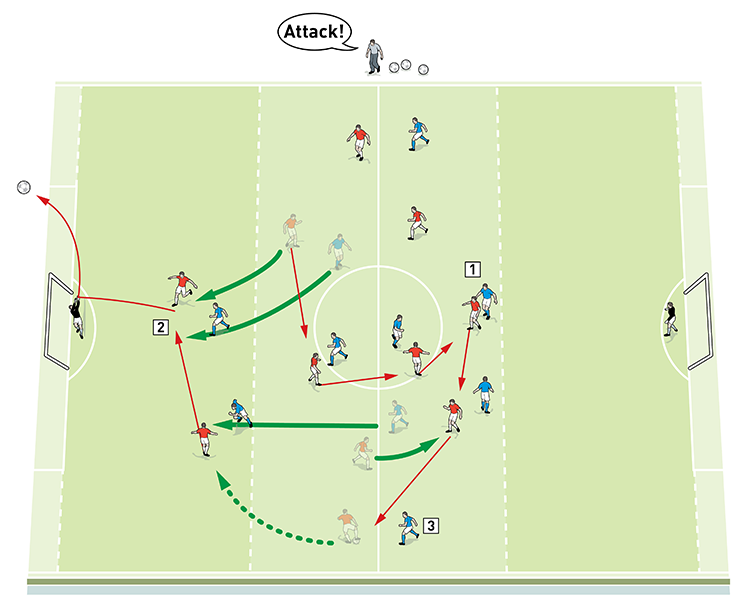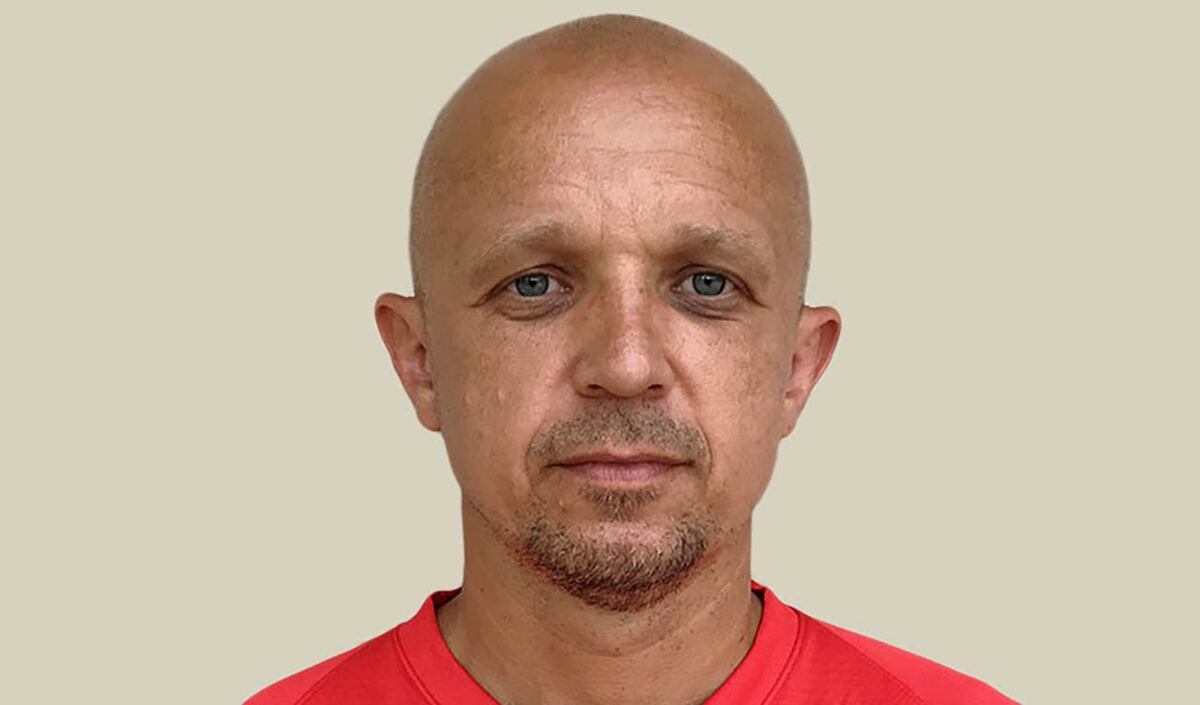You are viewing 1 of your 1 free articles
Attacking transition
| Area | Up to two thirds of pitch |
| Equipment | Balls, bibs, cones, poles, 1 target goal, 2 goals |
| No. of Players | 16 players + 2 goalkeepers |
| Session Time | Warm-up: 20mins Possession game: 20mins Attacking a low block: 20mins 4v3+1: 20mins 9v9 game: 20mins |
This session is all about the transition from defence to attack. Players love it because they get a lot of opportunities to express themselves and there are numerous ways to develop both individual and team learning on this topic.
It’s important we teach players skills that will prepare them to play at the highest possible level, skills that also reflect the developments in the modern and future game. Therefore, teaching them to recognise early opportunities to attack is an important part of the coaching process.
At PSG Academy Plantation, we work a lot on moving the ball forward as quickly as possible. Attacking transition is part of the coaching curriculum for all academy teams and age groups. This particular session has been designed for the professional development phase, from ages 17 to 21, but it can be easily adopted for the youth development phase, from ages 13 to 16.
What do I get the players to do?
Warm-up
We set up a playing area around the centre circle in the middle third of the pitch. The area is divided into four zones: the two halves of the centre circle form two zones (zones 1 and 2), while the halfway line separates another two zones (zones 3 and 4). We’re using 18 players split into three teams of six, with two balls per team that are in play simultaneously. Players must pass to a team mate in another zone and then sprint to change zones themselves, moving into any other zone. For clarity, we demonstrate this in our diagram as an overview of all three teams, as shown [1a], and in a close up representing the movement of just one team, as shown [1b].
1a

2. We’re using three teams of six, with two balls per team that are in play simultaneously
3. Players must pass to a team mate in another zone and then sprint to change zones
4. Here the blue in zone 4 passes to a team mate in zone 2 and then makes a run into zone 2
1b

2. Players should be limited to two touches if they can or three touches if needed
3. Players should accelerate quickly when making their runs
The player in possession needs to see the early opportunity to pass and must not spend too much time on the ball. We encourage players to limit themselves to two touches if they can or three touches if they need them. We want to see a sharp change of pace by the player after making the pass, accelerating quickly into another zone. An awareness of space and the position of supporting team mates is vital to the success of this busy and crowded activation exercise. The quality of passing and receiving is also key.
We can progress the activity by asking players to make their pass and then sprint to a third zone – one that has not been used in that passing move so far, as shown [1c]. This needs to be to a zone that the ball wasn’t passed to or from.
1c

2. Here the red in zone 3 passes to a team mate in zone 2 and then makes a run into zone 1. Alternatively, he could run into zone 4
We can progress the warm-up further by requiring players to make their pass to a player from a different team.
What do I get the players to do next?
Possession game
We set up between the two penalty areas with a goal and a goalkeeper at each end. The playing area is divided into thirds. We’re using 16 outfield players split into two teams of eight. We play an 8v8 game in the midfield third. On the coach’s call, the team in possession can break out of the middle third and try to score in either goal, as shown [2]. The other team must quickly try to defend against the attack. If the possession team scores in the goal, they get three points. Another way to score is for the possession team to make 10 passes in the central third and for this they get one point. Play always restarts from the midfield third.
2

2. On the coach’s call, the possession team break out of the midfield third and try to score in either goal
3. The blue defending team must quickly try to stop the attack
We want to see players reacting quickly to launch an attack and using good decision making to pick the best option for the attack, whether that’s the choice of goal or the decision to use individual attacking play over combining to attack.
Attacking a low block
We set up on two thirds of the pitch with a goal at each end. We’re using 16 outfield players and two goalkeepers split into two teams of nine. We play a 9v9 game with two conditions. Firstly, if the possession team loses the ball when attacking in the opposition’s half, every player from that team must recover back into their own half, with no immediate pressing allowed on transition. Secondly, the team that wins possession must make a pass in their own half before the ball can be played across the halfway line, as shown [3].
3

2. Condition 1: If the possession team loses the ball when attacking in the opposition’s half, every player from that team must recover back into their own half before they can press
3. Condition 2: The team that wins possession must make a pass in their own half before the ball can be played across the halfway line
At the end of the game, we get together with the players and compare the amount of goals that have been scored in this game with the amount scored in the previous game. This should demonstrate to players the importance of transition, as it will be harder to score whilst the opposition recovers behind the ball and builds a defensive block.
4v3+1
We set up an area of 60x40 yards with a small target goal at one end. The area is divided into thirds, with poles marking either end of the line between the middle third and the third with the goal. We’re using eight outfield players divided into a blue attacking team of four and a red counter-attacking team of four. One blue stays in his own defending third, while his three team mates start in the attacking third and try to score in the small goal protected by the four red defenders, as shown [4a]. When the reds win the ball, they must combine to transfer it over the red line and into the opposition’s defending third within five seconds. On the transition, the three blues can track back to defend and the lone blue at the other end must try to stop the ball crossing the red line.
4a

2. When the red defenders win the ball, they have five seconds to combine and run it over the red line at the other end
3. Supporting players should make runs to create space and offer passing options
4. One blue stays in his own defending third and tries to prevent the reds bringing the ball over the red line
5. On the loss of possession, the other three blues can recover to help their lone team mate defend the other end
To progress this activity, set the defending team the challenge of having to combine to transfer the ball into the opposition’s defending third before the three players from the attacking team are able to run around the poles and get back into their defending third, as shown [4b].
4b

This activity offers repeated opportunities to rehearse the transition to attack under pressure from opponents and under timing pressures too. It also gives us the opportunity to work with players individually. We want to see players making direct attacks with pace, while supporting players should make runs to create space and offer a passing option. Players should also demonstrate the skills to take on defenders, particularly when attacking the red line.
How would I put this into a game situation?
We would finish the session with a free play 9v9 game including keepers [not shown]. This is to check that the players have understood all the coaching points.
What are the key things to look out for?
The first thing we want to see is a positive attitude. Psychologically, players need to be very focused, positive and aggressive, and they must be on the front foot when setting up an attacking transition.
Technically, we want to see players showing us they have the ability to dribble and make the correct runs. Bravery on the ball is important, as is the ability to take players on and stay on the ball.
Tactically, there is a lot of decision-making involved in the activities, both on and off the ball.
What are the typical mistakes players might make and how do I avoid them?
At the beginning players try to play safe, playing the ball square or making back passes. As coaches, we should give them the clear message that the first pass or movement must be forward and that players off the ball must provide support ahead of the ball by making runs. As coaches we need to encourage creativity, giving a lot of vocal positive reinforcement.
Related Files
Editor's Picks
Deep runs in the final third
Using the goalkeeper in build-up play
Pressing principles
Intensive boxes drill with goals
Penetrating the final third
Creating and finishing
My philosophy
Pressing initiation
Compact team movement
Coaches' Testimonials

Alan Pardew

Arsène Wenger

Brendan Rodgers

Carlos Carvalhal

José Mourinho

Jürgen Klopp

Pep Guardiola

Roy Hodgson

Sir Alex Ferguson

Steven Gerrard
Coaches' Testimonials

Gerald Kearney, Downtown Las Vegas Soccer Club

Paul Butler, Florida, USA

Rick Shields, Springboro, USA

Tony Green, Pierrefonds Titans, Quebec, Canada
Join the world's leading coaches and managers and discover for yourself one of the best kept secrets in coaching. No other training tool on the planet is written or read by the calibre of names you’ll find in Elite Soccer.
In a recent survey 92% of subscribers said Elite Soccer makes them more confident, 89% said it makes them a more effective coach and 91% said it makes them more inspired.
Get Monthly Inspiration
All the latest techniques and approaches
Since 2010 Elite Soccer has given subscribers exclusive insight into the training ground practices of the world’s best coaches. Published in partnership with the League Managers Association we have unparalleled access to the leading lights in the English leagues, as well as a host of international managers.
Elite Soccer exclusively features sessions written by the coaches themselves. There are no observed sessions and no sessions “in the style of”, just first-hand advice delivered direct to you from the coach.









